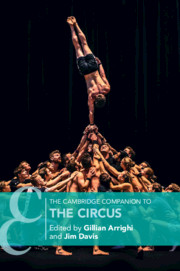Book contents
- The Cambridge Companion to the Circus
- Cambridge Companions to Theatre and Performance
- The Cambridge Companion to the Circus
- Copyright page
- Contents
- Figures
- Contributors
- Acknowledgements
- Timeline
- Introduction
- Part I Transnational Geographies of the Modern Circus
- Part II Circus Acts and Aesthetics
- Chapter 7 The Equestrian Circus
- Chapter 8 Animals, Circus, and War Re-enactment
- Chapter 9 Circus Clowns
- Chapter 10 Aerial Performance
- Part III Circus
- Part IV Circus Studies Scholarship
- Bibliography
- Index
- References
Chapter 8 - Animals, Circus, and War Re-enactment
Military Action to Colonial Wars
from Part II - Circus Acts and Aesthetics
Published online by Cambridge University Press: 22 June 2021
- The Cambridge Companion to the Circus
- Cambridge Companions to Theatre and Performance
- The Cambridge Companion to the Circus
- Copyright page
- Contents
- Figures
- Contributors
- Acknowledgements
- Timeline
- Introduction
- Part I Transnational Geographies of the Modern Circus
- Part II Circus Acts and Aesthetics
- Chapter 7 The Equestrian Circus
- Chapter 8 Animals, Circus, and War Re-enactment
- Chapter 9 Circus Clowns
- Chapter 10 Aerial Performance
- Part III Circus
- Part IV Circus Studies Scholarship
- Bibliography
- Index
- References
Summary
Thirty galloping horses at Astley’s Circus in 1824 underpinned the presentation of the Battle of Waterloo, which subsequently became a staple circus act during the first half of the nineteenth century. Military action was imbedded in the early circus, indicative of both an increased number of soldiers in nineteenth-century society and its ensuing militarisation. This chapter explores the use of horses and other animals in the re-enactment of war in the nineteenth-century circus. War re-enactments expanded to encompass colonial conflicts, so circus became complicit in colonising practices and attitudes to colonised peoples in the British colonies and towards exotic animals that were shipped in increasing numbers. In the 1880s a distinctive war-re-enactment genre emerged, exemplified by Buffalo Bill’s Wild West show, which toured internationally and was integrated back into circus. This chapter argues that it was the action of horses and other nonhuman animals that instigated and made battle re-enactment seem authentic but that circus war action replicated the pattern of actual war in which animals went unnoticed. This pattern was reversed with the Boer War re-enactment. Directed by circus entrepreneur Frank Fillis for the 1904 St Louis Exposition, it sought authenticity by featuring the death of fifty horses on the battlefield.
Keywords
- Type
- Chapter
- Information
- The Cambridge Companion to the Circus , pp. 127 - 140Publisher: Cambridge University PressPrint publication year: 2021



